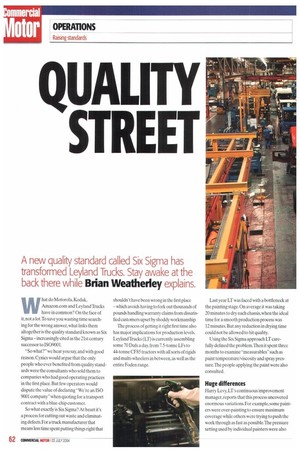QUALITY STREET
Page 64

Page 65

If you've noticed an error in this article please click here to report it so we can fix it.
A new quality standard called Six Sigma has transformed Leyland Trucks. Stay awake at the back there while Brian Weatherley explains.
What do Motorola, Kodak, Amazon.com and Leyland Trucks have in common? On the face of it, not a lot.To save you wasting time searching for the wrong answer, what links them altogether is the quality standard known as Six Sigma —increasingly cited as the 21st century successor to IS09001.
"So what?" we hear you say, and with good reason. Cynics would argue that the only people who ever benefited from quality standards were the consultants who sold them to companies who had good operating practices in the first place. But few operators would dispute the value of declaring"We're an ISO 9001 company" when quoting for a transport contract with a blue-chip customer.
So what exactly is Six Sigma? At heart it's a process for cutting out waste and eliminating defects. For a truck manufacturer that means less time spent putting things right that shouldn't have been wrong in the first place — which avoids having to fork out thousands of pounds handling warranty claims from dissatisfied customers upset by shoddy workmanship.
The process of getting it right first time also has major implications for production levels. Leyland Trucks (LT) is currently assembling some 70 Dafs a day. from 7.5-tonne LFs to 44-tonne CF85 tractors with all sorts of rigids and multi-wheelers in between, as well as the entire Foden range. Last year LT was faced with a bottleneck at the painting stage. On average it was taking 20 minutes to dry each chassis, when the ideal time for a smooth production process was 12 minutes. But any reduction in drying time could not be allowed to hit quality.
Using the Six Sigma approach LT carefully defined the problem. Then it spent three months to examine "measurables" such as paint temperature/viscosity and spray pressure.The people applying the paint were also consulted.
Huge differences I arty Levy, LT's continuous improvement manager,reports that this process uncovered enormous variations. For example, some painters were over-painting to ensure maximum coverage while others were trying to push the work through as fast as possible.The pressure setting used by individual painters were also affecting paint thickness.As Levy says: "By not actually changing anything [during the measurement phase] we found that things were changing themselves."
Having analysed the data. LT introduced a series of improvements to the paint line which included tighter control of the paint pressure, improvements to paint viscosity and extra training for the painters.The magic 12minute drying time was duly achieved — and the chassis arc now sprayed more evenly, using less paint, with lower emissions, and without compromising quality. To complete the trick the changes even reduced the cost of the painting process; something that no doubt brought a broad smile to the faces of Paccar's legendary bean counters.
Leyland Trucks has come to trust Six Sigma: since 1998 it has used this process to cut its operational costs by 5% a year.A11140 Six Sigma projects have led to quality improvements too. More changes are already planned for the Leyland Assembly Plant (LAP).The current build rate is some 320 trucks a week but by early September that figure will have risen to 345 following the merging of two frame lines. This process will, of course, incorporate the Six Sigma process.
The LAP must be doing something right: it was recently judged Britain's Best Engineering Factory by Management Today magazine and is one of Paccar's top performing assembly plants, winning the global Chairman's Award for Quality in 1991,2001 and 2002. In 2003 it picked up a RoSPA gold medal for occupational safety for the eighth consecutive year.
MD Stuart Hayes has no doubts about Six Sigma:-It relies for its success on the philosophy that higher quality equals lower costs, increased productivity and enhanced customer satisfaction. It makes the difference between '1 think so' and 'I know so'!" • US truck manufacturer Paccar, parent of Daf, Foden and Leyland Trucks, was a pioneer of the Six Sigma system.
In statistics "Sigma" is used as a measure of variation within a process; processes can be broken down into various Sigma levels.
For example, a Two Sigma level indicates 308,000 defects per million events or operations. A Six Sigma level indicates no more than three defects per million events. Any production line that reaches this level of excellence will all but guarantee satisfied customers.
In manufacturing the goal is to climb ever closer to the magic Six Sigma standard. The number of defects per million can be translated into a percentage. Sigma 2 equates to a rightfirst-time figure of 70%; Sigma 3 and 4 equate to 93,3% and 99.38% respectively.
According to Ad Benoist, a Six Sigma advocate at Daf Trucks: "That's a terrific result— but not good enough for world class manufacturing." The Holy Grail of Sigma Six demands a right-first-time rate of 99.997%. Leyland Trucks has either achieved or is moving towards Six Sigma in a number of areas within its assembly operation.






























































































































































































